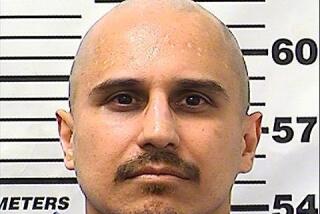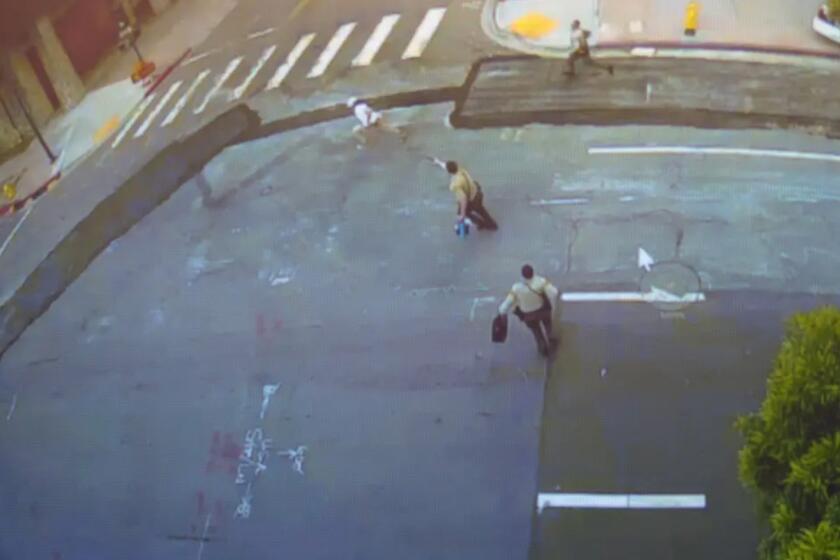How did an accused serial killer poison himself in jail?

Itzcoatl “Izzy” Ocampo at his arraignment in 2012. Ocampo committed suicide while in an Orange County jail.
Jailers thought Itzcoatl “Izzy” Ocampo was having a seizure. He was vomiting, shaking and later foaming at the mouth.
But Ocampo, an accused serial killer linked to the deaths of four homeless men, had drunk a cleaning product similar to Ajax.
How did he score poison in an Orange County jail? He got it from a fellow inmate, and he hoarded it under his bed.
Such were the findings of an investigation released Thursday by the Orange County district attorney’s office into the death of Ocampo, the former Marine who was accused of killing six people, including four homeless men, and a woman and her son. The 25-year-old was found vomiting and shaking in his single-man cell at Santa Ana’s Central Jail on Nov. 27, 2013, and he was pronounced brain dead the following day.
The report by Senior Deputy Dist. Atty. Scott Simmons details how Ocampo was able to score cartons of the powdered cleaner and ingest it the day before he died. And although Ocampo had shown suicidal tendencies in the past, leading some to question why he was not in a more secure housing area, the report absolves the Orange County Sheriff’s Department of any criminal wrongdoing.
“It would be unreasonable…to conclude that anybody acted in a criminally negligent manner when Ocampo was allowed to receive the small quantities of cleaning solution, just like all the other inmates,” Simmons wrote in his report.
Michael Molfetta, an attorney who represented Ocampo, accepted the conclusions of the report but castigated the Sheriff’s Department for how it handled his client.
“Letting someone like Izzy Ocampo hoard what is essentially poison is, no matter how you couch it, it’s simply stupid,” Molfetta told The Times. “They needed to keep the poison away from him … If you talked to Izzy Ocampo for three seconds, it’s not hard to figure out this was a troubled person.”
In Ocampo’s section of the Central Jail, one inmate was assigned the job of scrubbing the outside areas of cells using the powdered cleaning product. An inmate could request small portions of the cleaner and use it to wash his cell.
“They were responsible for cleaning their own cells,” Simmons told The Times. Ocampo began requesting the cleaning solution about three days before he was found ill in his cell.
The suicide prompted the Sheriff’s Department to immediately switch to a nontoxic cleaner in the jails, said sheriff’s spokesman Lt. Jeff Hallock.
Ocampo’s death foreclosed what would have been a dramatic, high-profile criminal case for the district attorney’s office, which had announced it was seeking the death penalty.
Prosecutors alleged that Ocampo started his killing spree in Yorba Linda on Oct. 25, 2011, with the stabbing death of a high school friend’s brother, Juan Herrera, 34, and their mother, Raquel Estrada, 53.
His slayings moved to the streets, with Ocampo linked to the deaths of four homeless men. Ocampo told police he targeted homeless people because they were “available and vulnerable” and he believed he was performing a public service because their presence blighted the community, authorities said.
Between December 2011 and January 2012, Ocampo was accused of fatally stabbing James Patrick McGillivray, 53; Lloyd Middaugh, 42; Paulus “Dutch” Smit, 57; and John Berry, 64, in separate incidents.
The report sheds light on the nearly two years that Ocampo was behind bars after his arrest on Jan. 13, 2012. He was initially placed in protective custody under suicide watch. After he was released to a less restrictive observation area, Ocampo was found faking unconsciousness and on one occasion, he intentionally hit his head against a wall – which prompted staff to return him to suicide watch, according to the report. He was prescribed a slew of medication for depression, anxiety and post-traumatic stress disorder.
But his behavior apparently improved. In the half-year before he died, Ocampo was described as “calm and cooperative.”
He once told a fellow inmate – the same one who doled out the cleanser – that he’d “take a big shot of heroin and kill himself” if he was sentenced to life without parole. The inmate thought Ocampo was joking.
After toxicology tests returned, the county coroner’s office ruled that Ocampo committed suicide. Investigators found acute swelling of the brain, high levels of toxic substances and fluid in the lungs, according to the report.
Prosecutors concluded: The Sheriff’s Department did not fail “to perform a legal duty owed to Ocampo.”
For breaking news in California, follow @MattHjourno.
More to Read
Start your day right
Sign up for Essential California for news, features and recommendations from the L.A. Times and beyond in your inbox six days a week.
You may occasionally receive promotional content from the Los Angeles Times.






